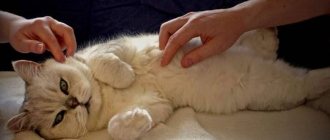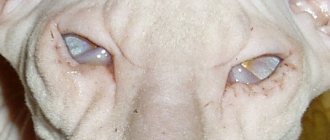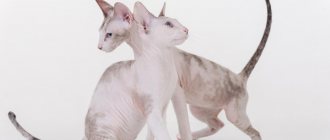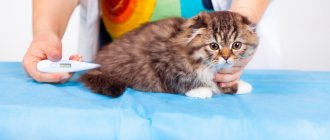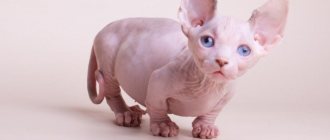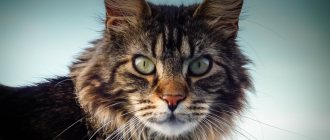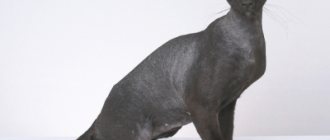Low or high body temperature in sphinxes can signal serious health problems that need to be eliminated as soon as possible with medications. If the temperature does not stabilize over the course of several days, and the cat experiences fever, fever, nausea and other unpleasant symptoms, then you should not delay contacting the veterinary clinic.
Normal temperature for a cat
It is important to know that cats' body temperature is higher than that of humans.
37.8 is the optimal temperature for your pet. Cat owners should know that the optimal temperature for their pet ranges from 37.5-39 degrees, which is much higher than that of humans. It is important to note that different breeds have different indicators as the norm. For example, for a sphinx the norm is 40 degrees, but for others this is already a signal of pathology.
A thermometer is the most reliable way to measure a cat's temperature.
And just like people, cats often suffer from fever. As a result, the question arises, how do you know if the temperature is elevated? The methods that people use are not suitable for this. If you feel your pet's forehead, you will not be able to judge the presence/absence of temperature. Most people are accustomed to determining the condition of cats by their nose. If it is damp and cool, then everything is fine, but when it is hot and dry, you should sound the alarm.
The most proven and reliable method of determining temperature is using a thermometer. It is placed either in the rectum or ear canal. Don’t be afraid of the animal’s reaction; naturally, whims and manifestations of character will begin, but despite this, you will have to measure the temperature!
If your pet's body temperature rises, there is no need to take risks. Contact your veterinarian as soon as possible.
In addition, there are certain symptoms that signal this pathology. With their help you will know whether you need to measure your temperature or not. If the result shows 39.4 degrees Celsius, seek help from a veterinarian.
Symptoms
If your cat has become lethargic and sleepy, this may be due to an increase in its body temperature.
- Lack of usual appetite.
- Apathy, lethargy and weakness.
- Presence of tremor, trembling.
- The cat has a rapid heartbeat.
- The pet's weakened body becomes dehydrated.
- Strange behavior, state of shock.
If these symptoms occur, you cannot do without the help of a veterinarian.
Signs of hypothermia
A low temperature in a Sphynx can be fatal if the owner does not notice the problem in time and does not contact a veterinarian. When hypothermia occurs, the temperature drops to 37 and below; the critical mark on the thermometer is 28. Pathology can be recognized by additional symptoms:
- weak palpation of the pulse;
- rare breathing;
- pale mucous membranes and skin;
- trembling in the muscles of the Sphinx;
- poor sensitivity;
- lethargic and apathetic state;
- wide pupils.
Return to contents
What to do at elevated temperatures
If you have a cat or cat, it doesn’t matter at all; you should familiarize yourself with the main reasons why such a pathology is observed. This is necessary so that you detect the problem in a timely manner and consult a doctor without wasting unnecessary time on reflection.
- Overheat. This reason is considered one of the most common. If an animal is exposed to the sun for a long time, temperatures can jump to 41 degrees or higher. Why is this happening? In addition to exposure to the sun, this happens due to the fact that the cat is locked in a stuffy room or during transportation. It is important to provide first aid to your pet correctly. Place the animal in a cool room and give it some water. The temperature should stabilize within two hours.
Overheating is the most common cause of fever in cats.
- Viral diseases. It is common for cats to get sick even from viral diseases. The following signs are observed: mucus from the nose, tearing and even sneezing. In this situation, you need to make sure that the humidity of the room in which the pet is located increases, and give it water.
If your cat has a fever, he may have contracted a viral disease.
- Infectious diseases.
Pets may be exposed to infectious diseases. In addition to high temperature, this is indicated by the following symptoms: decreased urination, weakness and vomiting, poor appetite. Rest assured, this is a reason to seek help from a veterinarian. Veterinarians recommend giving your cat water when the temperature rises. - Emotional shock. Stress is considered to be one of the causes of pathology. Often cats experience emotional stress in such cases: visits to the veterinarian and exhibitions, loss of their owner, moving, long separation from the owner, etc. To help your cat, take whatever steps are necessary to calm her down. Basically, stressful temperature surges pass when everything falls into place.
Separation from the owner can cause serious emotional shock to the cat.
In addition to the reasons listed, such symptoms are observed in overly active and pregnant cats, as this is a physiological process.
Sometimes oncology is to blame, so you should contact a veterinarian without delay to avoid an irreversible and extremely sad process.
If the Sphynx's body temperature is above 39 degrees, then this is a clear sign of illness and a cause for concern.
- Body temperature exceeds 39 degrees;
- Breathing quickens, the pet breathes through the mouth, sticks out its tongue;
- Rapid breathing, while the depth of inspiration is insufficient;
- The pet is lying down, there are no reactions (does not respond to the owner’s voice or touch);
- The pet is wandering in an unknown direction, and the body language does not look natural (the cat is probably in a disoriented state);
- Changes in the color of the mucous membranes (from bright to whitish);
- Very weak pulse, beats are almost impossible to count.
- It is necessary to wrap the cat in a wet towel;
- Gently wipe the animal's face and ears with a damp cotton pad;
- Place in the coolest place in the room;
- Try to drink cool water.
https://www.youtube.com/watch?v=N_eWP2yZHLs
Regardless of whether the animal feels better or not, the cat must be urgently shown to a veterinarian. Even if it seems that the danger has passed. Since overheating for the Sphinx is fraught with swelling of the brain and lungs.
We hope this article was useful to you!
Useful materials:
- Cutaneous horn
General description of the disease Cutaneous horn on the forehead or face (ICD 10 code - L57.0) -... - Itching and odorless discharge Main causesBefore considering the factors that provoke the appearance of discharge that has a sour odor, it is necessary to immediately note...
- Discharge in women What kind of discharge between menstruation is considered normal? Female discharge normally consists of mucus from the cervical canal, dead...
Children and older cats are most often susceptible to hypothermia. Symptoms of such a process are noticeable trembling of the whole body, apathy and complete indifference to games, slow breathing and heartbeat, dilated pupils, pale visible mucous membranes, fluffy fur, the pet’s attempt not to freeze under a blanket or radiator by curling up and covering its nose with its tail or paws.
The reason for a decreased body heat index may be:
- hypothermia;
- infectious and viral diseases that have a destructive effect on the animal’s immune system;
- lack of appetite, loss of weight and muscle mass;
- an unwell, weakened body after suffering an illness or injury;
- malignant tumors;
- kidney failure and disease;
- disruption of the metabolic process due to a high lack of beneficial microelements and vitamins;
- poisoning and dehydration of 1/10 of the body;
- excessive blood loss, including internal bleeding;
- diseases of the heart, intestinal epithelium in kittens, central nervous system.
Note! A decrease in temperature to 35-32 °C is a mild form of hypothermia, to 32-28 °C is moderate, and less than 28 °C is deep.
Wrapping yourself in a blanket or a warm terry towel, on top of which a heating pad with water at 39 °C is placed in the back area, and frequent warm drinks (milk or fatty broth) will help increase the indicator to the normal level. If there is wet wool, dry it with warm air from a hair dryer. When the temperature rises by a couple of tenths of a degree, it is recommended to feed your pet a small amount of warm food. Prolonged hypothermia can lead to pneumonia, kidney disease, or inflammation of the surface of the brain.
Important! The inability to raise the temperature on your own to the normal limit or reaching 36 ° C and its further decrease is a reason for an urgent trip to the veterinary clinic. Professional diagnostics will help establish an accurate diagnosis and prescribe effective treatment.
Knowing what the normal temperature is for cats will help identify deviations from generally accepted standards. A change in the pet’s usual behavior and the manifestation of characteristic symptoms will indicate the need for preventive measurement of the thermal index, the timeliness of which will allow the necessary assistance to be provided.
We invite you to read the Report about your pet cat
Why do kittens have higher temperatures than adult cats?
Having been born, a little kitten finds itself in an unusual, constantly changing world. His body does not yet know how to adapt to these changes. The training process lasts about three months.
All this time, the kitten’s body temperature is about half a degree higher than that of an adult. The baby’s thermoregulation system is still imperfect, so the body protects itself from hypothermia just in case. By three months, the process of “tuning” the kitten’s body ends and the temperature readings become the same as those of an adult pet.
An attentive owner immediately notices an increase in a cat’s temperature:
What to do at elevated temperatures
The health of a domestic cat directly depends on the conditions in which it lives. However, no one can be immune from disease.
This is why a cat’s body temperature may rise, despite high-quality care and excellent living conditions.
Impaired heat transfer in cats occurs due to the influence of external and internal factors: stress, infection, simple overheating.
Give your pet a separate place in the house where he can spend time and relax alone. The best location for a cat bed is away from hot radiators, drafts and doors.
Make sure that the animal is constantly warm and not overcooled, otherwise it may catch a cold. If the apartment is cool, you can wear special clothes on the sphinx.
You should give medications to your pet only after the doctor’s recommendations.
As for treating a cat, it all depends on the cause of this pathology, as well as the severity of the situation. In some cases, there is no need to panic, since the animal’s body is able to independently fight some viruses and infections.
If the diagnosis is not entirely clear, the doctor prescribes a course of treatment using antibiotics. Antipyretics are often prescribed, but it all depends on the cause. Before giving any medications to your cat, consult your veterinarian to avoid serious complications.
Folk remedies
What to do at home? It is advisable to use cool water to dampen the cat's fur. If you have ice, you can safely apply it to the cat's neck and also to the inner thighs. As for more radical treatment, it is better to consult a doctor. Provide the animal with enough fluids.
The health of a domestic cat directly depends on the conditions in which it lives. However, no one can be immune from disease.
This is why a cat’s body temperature may rise, despite high-quality care and excellent living conditions.
Impaired heat transfer in cats occurs due to the influence of external and internal factors: stress, infection, simple overheating.
Don Sphynxes are not adapted to life in natural conditions. Tree branches and claws of other animals can cause serious injuries to your pet. The absence of a natural “fur coat” results in the kitten’s tendency to freeze. That is why keeping a Don Sphynx is only possible in an apartment or house, provided that suitable conditions are created for the pet.
Care: basics
To ensure a comfortable stay for the Don, always ensure cleanliness. The tray must be removed promptly. A bald pet will never go to a dirty “toilet”. Monitor the condition of the bowl. This neat guy would rather proudly suffer from hunger than eat from a dirty bowl. In addition to ensuring cleanliness, take care of other procedures.
- Wiping. The Sphinx is sweating a lot. Protruding sweat gives the pet an unpleasant color and smell. But this is not the only disadvantage. Cat sweat is colored, making it easy for the dong to contaminate your home. To avoid this, it is recommended to wipe the cat daily with a soft cloth and lotion.
- Bathing. Once a week, the pet needs a full bath procedure. Use only special shampoo with a neutral pH. Rinse all wrinkles and folds thoroughly. Sphynxes enjoy bathing. Therefore, both you and the don will enjoy water activities.
- Eye care. This is the Don's weak point. The cat has no eyelashes at all. Therefore, unprotected eyes are much more likely to develop pathologies. Monitor their condition carefully. Rub your eyes with chamomile infusion twice or thrice a week.
- Ear cleaning. Check your ears once a week. Remove accumulated sulfur as it gets dirty.
- Teeth cleaning. To protect your pet from the formation of stones, it is better to purchase a special toothpaste and brush. Canines can be cleaned once a week.
- Trimming claws. Check the claws every two to three weeks. If your pet does not wear them off while walking outside, then it is necessary to trim the nails in a timely manner.
Despite the extensive list of required procedures, maintaining the Don Sphynx is not as complicated as it might seem. The pet heroically endures all procedures, even claw trimming, because it trusts its owner immensely.
Feeding
When it comes to food, Don Sphynxes are completely picky. They will gladly absorb everything that their owner offers them. Since the body temperature of pets is slightly higher than that of other cats, their metabolism proceeds faster. Therefore, they require more food. You can feed your don regular food or dry food.
If the choice fell on natural feeding, then the diet must include:
- meat - boiled or frozen;
- fermented milk products - cottage cheese and kefir are especially useful;
- sea fish - twice a week;
- vegetables - boiled beets, carrots;
- boiled cereals - buckwheat, rolled oats, rice;
- eggs - once or twice a week.
Veterinarians recommend feeding your pets with ready-made food. In this case, the don will receive a completely balanced diet containing all the nutrients he needs.
Breeding
If you are planning to breed Don Sphynxes, then be prepared for the fact that you will have to take into account many different points and consult with experienced breeders more than once. After all, even in professional nurseries, strong and healthy offspring are not always born. Each stage of breeding must be taken seriously.
- Maturation. Cats reach puberty early. The first heat appears at six months. Don't rush into mating. A cat reaches puberty later, at approximately eight months.
- First mating. The first mating of a Don Sphynx can occur at the age of one and a half years, and not earlier. All vaccinations must be completed before mating. Take both pets to the vet. Mating always takes place on the territory of the male. To prevent the cat from worrying, grab a few of your pupil’s favorite toys, a personal house, a bowl and a tray.
- Pregnancy. During pregnancy, a cat's behavior does not change much. But from about the sixth week, you can easily determine your pet’s condition by swollen nipples and increased body weight. The Sphynx's pregnancy lasts 64 days.
- Childbirth. Lambing among sphinxes, even among first-time mothers, proceeds quite calmly. Labor can last a day, but usually goes much faster. If a cat experiences difficulties during childbirth, it may ask its owners for help.
If you do not plan to breed Sphynx cats, then it is better to spay and neuter your pets. Sterilization of a girl can occur between the ages of one and six months, before her first heat. Castration is also recommended before the male's first spree, at approximately six to seven months.
Each type of animal has a body temperature that is optimal for its existence. Body temperature in animals is maintained at the required level with the help of various organs, including the nervous system, pituitary gland and hypothalamus (a part of the brain responsible for many functions, including heat exchange).
Many factors involved in maintaining body temperature are not yet fully understood. In cats, a normal temperature is considered to be in the range of 37.5 – 39 degrees. Moreover, each cat has its own individual body temperature norm. However, it turns out that the temperature of healthy adult Sphynx cats is the same as that of ordinary cats, despite the fact that Sphynx cats appear tactilely much hotter than their feline counterparts.
The second common misconception is that Sphynx cats cannot control their body temperature. Indeed, due to the lack of wool, it is a little more difficult for them to stay warm. When Sphynxes are cold, they, like other cats, look for a warmer place. And it doesn’t matter what it is: the owner’s knees, a blanket or a battery on which a special hammock can be attached. And yet, more often than not, Sphynx cats prefer their owner’s bed or a warm blanket.
We invite you to familiarize yourself with the Withers in cats and female cats: where is || Where is a cat's withers and how to find them
If you see that your Sphynx is cold, dress him up! This could be a special suit from a pet store, or a hand-knitted blouse. Some inventive owners simply cut the sleeves off old sweaters, turning them into designer clothes for their pets.
Sphynxes have a very high energy metabolism, so their body temperature is still 0.5 - 1 degree higher than that of ordinary cats.
It is no secret that the body temperature of sphinxes is an indicator of health.
Healthy adult Sphynx cats have an average body temperature of 38-38.5 degrees. In small kittens it may be a little higher, up to about 39 degrees. Temperature above 39 degrees - the kitten is sick!
Having been born, a little kitten finds itself in an unusual, constantly changing world. His body does not yet know how to adapt to these changes - especially in Sphynx kittens. The training process lasts about three months.
All this time, the kitten’s body temperature is about half a degree higher than that of an adult Sphynx. The baby's thermoregulation system is imperfect, so the body protects itself from hypothermia just in case. By three months, the process of “tuning” the kitten’s body ends and the temperature readings become the same as those of an adult pet.
If you suspect that your baby is not healthy, then it is best to use a thermometer to determine the temperature. Temperatures in cats are measured rectally.
In order to determine how different a pet’s temperature is from normal, it must be measured. It is better if the owner knows what his kitten’s normal temperature should be, because these indicators are still individual. To do this, it was necessary to measure the body temperature of a healthy kitten in the morning and evening for several days.
Then it is easy to determine how different these values will be for a sick baby. And in the future, you will always be able to correctly navigate the kitten’s body temperature: is it sick or healthy. Most often, various sites will tell you how unpleasant this procedure is for a cat and what to do with it Animal owners need to prepare carefully.
Moreover, it is better if the animal owner carries out the measurement not alone, but with an assistant. “Before starting the measurement, the cat’s paws must be secured, swaddled with a strong towel of sufficient size; the head should be held by the scruff of the neck, as the animal may try to bite; the tip of the thermometer is carefully inserted into the anus to a depth of about two cm and kept there for the required time. Then readings are taken and the thermometer is wiped with alcohol.”
What is the body temperature of Sphynx cats?
Hello friends. What do you know about the Canadian Sphynx? These are extraordinary cats without hair, similar to fairy tales...
Sphynx cats are perhaps the most unusual representatives of the domestic cat kingdom. They seem to be some kind of alien creatures. There are many misconceptions about them that need to be addressed.
In mythology, the sphinx is a monster with the body of a lion and the face and breasts of a woman. The most famous statue is the Great Sphinx.
We suggest you read: Which cats are better at catching rats and mice
According to the definition of Titus Flavius, a Roman scientist and writer, the Egyptian sphinx is a symbol of strength and intelligence: the lion's body denotes strength, the human face - intelligence. The sphinx needs both strength and intelligence to guard pyramids and temples full of treasures.
Contrary to the associative opinion that cats - sphinxes - came from Egypt, the first mention of them appeared among the Aztecs. They were called Mexican hairless cats.
An interesting fact: for most of the year they were indeed bald, but with the onset of cold weather they grew overgrown with fur, which they then “shed” during the warming period.
There were also references to hairless cats - participants in cat shows of the 20s, but the last pair of animals, unfortunately, did not leave offspring. In the 1930s, hairless cats were reported from France, Morocco and the United States. French biologist professor E.
Lethar documented hairless kittens born from a pair of Siamese cats and described a mutation caused by the h gene.
The first modern hairless kitten was born to a Canadian cat in 1966. The breeders became interested in the original cat and did everything possible to continue the breed. And in the late 80s, the first hairless cat was born in Rostov-on-Don, becoming the founder of the Don Sphynx family.
At the same time, St. Petersburg felinologists developed the Peterbald breed, independently of their Rostov colleagues. All three varieties have not only external, but also emotional differences.
The Canadian Sphynxes are considered the calmest and friendliest, distinguished by their rounded ears and smooth lines.
The Don Sphynx has a more elongated and sharply defined muzzle, while Peterbalds are distinguished by the greatest sophistication, huge ears and elongated proportions.
In addition, each breed has acceptable coat options - from completely bald “rubber” cats without mustaches and eyebrows to those covered completely or partially with hair of different lengths. It's funny that at first they tried to treat the first-born Sphynx cubs for lichen, until they realized that the lack of hair was a normal feature of their body.
The body temperature of adult Sphynx cats can reach 39 degrees. They love to sleep under a blanket next to their owner - they warm themselves.
This same feature is responsible for the rapid progression of colds and excellent appetite - the Sphynx's metabolism is much faster than that of cats of other breeds.
If the room in which the sphinx lives is too well heated, and the temperature in it exceeds 20-25 degrees, brown, waxy sweat appears on the animal’s body. However, the latter can be easily wiped off with a damp cloth.
The skin of sphinxes is quite dense, which simplifies the injection procedure during treatment. It will be quite easy to give an injection to a “naked” animal.
Due to the specific characteristics of the skin, short-term sunbathing is recommended for sphinxes, but in no case leave your pet for a long time under the scorching midday rays - the skin of these cats burns faster than that of a person. Most Sphynx cats love to bathe, but you should choose detergents from the gentle children's category.
We invite you to read: Colors of Maine Coon cats – Zhivomag
Despite their frightening appearance for most, sphinxes are distinguished by their friendly nature and high degree of socialization. This is an animal that is directly contraindicated from being alone for a long time. Many breeders notice “canine” character traits in their pets - incredible loyalty, sociability and trainability.
The Sphinx is one of the few cats that will respond and come running when they hear their name, not because you are holding a piece of sausage in your hands, but simply because you called.
In addition, these cats are similar to humans - they have natural toes on their paws, and sphinxes prefer to sleep under a blanket, with their heads on a pillow.
The Sphinx puts itself on the same level as its owner, preferring equal relationships rather than the royal behavior inherent in cats.
Thanks to their enviable metabolism, Sphynx cats have an excellent appetite and a complete lack of pickiness. But there are also pitfalls here - unlike the usual breeds of cats, the Sphynx rarely leaves the bowl half empty, so you need to feed it in portions and very carefully to prevent overeating.
Particular attention should be paid to the animal's ears - increased secretion provokes plaque accumulation faster than in an ordinary cat.
Some veterinarians, not knowing the specifics of the breed, begin to treat a cat for ear mites, so be careful and warn the doctor about the characteristics of your pet that you know.
Otherwise, the Sphynx is much easier to care for and maintain than long-haired cats. It does not leave wool on clothes and is highly clean.
Elongated proportions, curved front legs and lack of hair create the impression of a gentle and defenseless creature, including against viruses and infections. Add to this the stereotype about the good health of outbred cats and the weakness of purebred cats, and you get the myth that with a Sphynx you will not leave the veterinarian's office.
In fact, the immunity of the sphinx is in no way inferior to the immunity of the yard Vaska, and even vice versa. Elevated body temperature helps to quickly cope with viruses and infections. Even if the Sphynx has a cold, he will recover fairly quickly.
Don’t be afraid to give your pet physical activity - playing with a fishing rod, balls and in cat complexes will strengthen the body and help maintain the health of the Sphynx.
Many allergy sufferers who dream of having a pet at home opt for Sphynx cats, arguing that they have no fur.
In fact, the main cause of cat allergies is not fur, but an allergenic protein found in saliva, sebaceous gland secretions and particles of the animal's epidermis.
Symptoms may be reduced because the Sphynx grooms herself less often and does not leave allergens along with her fur throughout the apartment, but this does not mean that the reaction will be completely absent.
If you decide to get a hairless pet and are convinced that the reaction to it is not as intense as to fluffy cats, remember a few simple rules. First, intact males produce more allergen than castrated males.
We invite you to familiarize yourself with: Domestic cat breeds bred from wild counterparts
Secondly, dark cats produce significantly more allergens than light cats. And thirdly, cats produce more allergens than cats.
In fact, no breed of cat is confirmed to be hypoallergenic, so you need to select a pet individually.
This article will talk about what the body temperature of sphinxes should be. And also what should be done if your pet has an elevated temperature or hypothermia.
Don Sphynx: description of the breed
The Donskoy pet has a very characteristic appearance. Its distinctive feature is the absence of wool. Some pets may have a little fluff. A wrinkled body is always hot. The body temperature of the Don Sphynx is 39.5-40°C. The pet is characterized by a powerful physique, strong bones and developed muscles. Caring for the Don Sphynx is not difficult if you follow the main rule - always and everywhere keep it clean.
Main features of the breed.
- Weight. Sphinxes are quite heavy. They weigh more than their appearance suggests. The cat's body weight is 3.5-5 kg. A cat can reach a weight of 5-7 kg.
- Height. Dons are among the medium-sized cats. The pet's height is 25-30 cm. The dimensions of sterilized pets may exceed the specified parameters.
- Color. The standard allows any color.
- Lifespan. Usually a pet pleases its owners for about 12 years. But if the Don Sphynx lives in constant care and love, it can reach 15 years of age.
- Character. A pet can be described in one simple phrase - a companion cat. This is a devoted friend who will relentlessly follow his owner. But sometimes a pet can be intrusive. Sphynxes are sociable, energetic, and playful. They are inquisitive, affectionate and always in a good mood.
- Intelligence. Sphinxes are very smart. They unmistakably sense any changes in the owner’s mood and masterfully adapt to it. Intelligent pets quickly learn the rules of behavior and almost never break them.
Dons are very touchy. This is confirmed by reviews of the Don sphinxes. However, even the most upset kitten will never stoop to petty sabotage. He will simply look at you with such sad, sorrowful eyes that you will have to ask him for forgiveness for a long time.
Breed standard
The exotic pet was treated with caution for a long time. There was an opinion that the hairless cat was just a joke. And only over the years did people become convinced that this was a separate breed, and not a carefully shaved pet. And given the friendly nature of the Don Sphynx, it is understandable why it quickly became a source of prestige and pride. If you decide to become the owner of this unique cat, then read its description in the table.
Table - Don Sphynx breed standard
| Part of the body | Description | Flaws |
| Head | — Wedge-shaped; - defined cheekbones, eyebrows; - flat forehead with vertical folds; - slightly pronounced transition to the forehead; - short muzzle; - thick, convoluted vibrissae, often broken off | — Narrow shape; - short or round head |
| Eyes | — Almond-shaped; - medium size; - set askew; - any color | Round form |
| Ears | - Large, widely set; - slightly tilted forward; - rounded ends | - Low or close set; - small |
| Torso | — Muscular, strong; - wide croup; - deep inguinal line; - strong, durable bones; - straight forearms | - Short, weak body; - little weight |
| Tail | - Straight; - long; - flexible | — Incorrect form; - short |
| Leather | — Elastic, wrinkled; - excess in the groin, armpits, neck and head; - sometimes covered with light thin fluff | Excessive hair presence |
Colors
The colors of sphinxes are varied. However, these pets never have bright, expressive shades. Sphinxes can be monochromatic. It is not uncommon to find cats that combine several colors. The most popular colors of the Don Sphynx are:
- White. The pet may have a small white fur. If the cat is completely hairless, then the skin tone is more flesh or cream than white. Any eye color is allowed. Among white dons, cats with different-colored eyes are more common.
- Black. Characterized by different pigmentation. Therefore, the pet can be either black or gray. The edging of the eyes and paw pads are always black. Eyes can be any color.
- Blue. This is a gray pet. It is similar to black, but has significant distinctive features. A blue cat's pillows, nose, and ear rims are always gray.
- Red. The shade of the bottom can be light cream or warm, rich red. Sometimes the skin color appears red. The red color is often accompanied by a tabi pattern.
- Tortoiseshell. This color can only be observed in a “girl” sphinx. There are several varieties: black tortoiseshell (black and red), blue tortoiseshell (gray-cream), lilac and chocolate.
- Thorby. Such pets are characterized by a combination of tortoiseshell color and tabi pattern.
Advantages and disadvantages
“Alien” pets, which can shock with their appearance, have many advantages. Sometimes it seems that they have absorbed all the best features inherent in cats. However, there are also some disadvantages, as can be seen from the table.
Table - Advantages and disadvantages of the Sphinx
| pros | Minuses |
| — Friendly towards people, children and animals; - sensitive, sensitive to the mood of the owner; - smart; — easily adapts to the living conditions of the owners; - playful, will become a source of joy and fun; - devoted; - hypoallergenic | — Likes to sit on hands; - touchy, although he will not be angry for a long time; - excessively clean and very picky about the condition of the tray; - overly sociable; - requires a lot of attention; - looks unattractive |
We suggest you read why a cat needs a mustache, and what will happen if you cut it off - Leisure
It may be below normal due to various factors. Representatives of the cat family at an advanced age have a lower temperature, but this is not a pathology.
In a sleeping animal, due to the slowdown of processes in the body, the temperature fluctuates between 36.5-37 degrees, because energy costs are reduced and there is no need to produce additional resources.
If a pet is sick, the temperature drops as a result of heart disease, kidney disease, blood vessels, the effects of stress, surgery or traumatic experience. Blood loss is one of the factors influencing the decrease in temperature.
When the pet's thermoregulation system is disrupted, its body temperature rises. This indicates the beginning of the incubation period of the disease or its absence.
There may be several reasons:
- viral infection, the appearance of harmful microbes or parasites in the animal’s body;
- intoxication;
- stress factor;
- prolonged physical activity or pregnancy.
Studying the symptoms and the attentive attitude of the owner towards his pet will help to complete the overall picture.
History of the origin of the Don Sphynx breed
still legends surrounding the history of the origin of the Don Sphynx cat . Someone claims that towards the end of the 1980s, Elena Kovaleva, a professor at one of the universities in Rostov-on-Don, saved a kitten from the “paws” of cruel children who abused the animal. According to another version, more prosaic, a compassionate woman picked up an unsightly foundling almost in a trash heap.
After a few months, the seemingly normal pet began to go bald. The breeder tried everything she could to cure the poor thing. But overall, the Don cat felt good and was quite happy with life. So, after a couple of years, a hairless cat from a union with a local cat gave birth to kittens, the spitting image of their mother.


